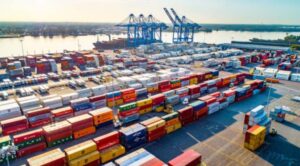A port can be defined as a harbour or an area that is able to provide shelter to numerous boats and vessels (transferring people or cargo), and can also allow constant or periodic transaction of shipment.

Considering a variety of factors such as location, depth, purpose, and ship sizes, ports are classified into various types. Some of the main types are as follows:
Inland Ports
Inland ports are ports built on comparatively smaller water bodies such as rivers or lakes. They can either be for cargo purpose or for passengers or for both. Conventionally Inland Ports are constructed or naturally maintained ports at the coastline of small waterways like lake, river or estuaries and rarely seen at sea coasts too.
Some of these inland ports can have access to the sea with the help of a canal system. As such ports are built on inland waterways they usually behave like normal seaports but are not able to allow deep draft ship traffic.
Some of the inland ports can be also be specifically made for recreational purpose allowing only small-sized vessels or can be used just for ferrying people and fishing activities.
Inland ports are known for their quality to function in a smooth manner, unlike the clogged seaports. These ports can also sometimes be referred to as dry ports, and are similar to active intermodal hubs. The inland port at Montreal is the biggest of its kind.
Inland ports are conventionally maintained for quenching the needs of stocking and dispatching of cargo but sometimes these are also made open to passengers too. These are shallower than seaports so they don’t allow deep docking, but only docking to ferries is allowed at inland ports.
Inland transport services are used to connect these inland ports (generally called rail or road terminal) through marine terminals. For e.g. St. Lawrence Seaway is an important inland port.
Intermodal transportation and tanker ships are on their peak in the international market due to the development of Inland ports which are also referred to as Inland freight distribution ports, which are a hub for inland waterway trades mainly due to their congestion-free space availability and adequate capacity.
Inland terminal is the key connector for trading expeditions between two regions, not only for inbound traffic but also in serving outbound traffic. This port also has to handle various concerned logistic activities. Important functions of Inland ports are summarized below as:
Fishing Ports
Fishing ports are mainly related to the commercial sphere as they participate in fishing. The fishing activities can also be treated as a mode of recreation. The existence of a fishing port entirely relies upon the availability of fishes in that region of the ocean. A fishing port can be an inland port or a seaport.
Often, fishing ports are marketable port which is generally used for recreational purposes or aesthetics. These are the ports which allow controlled and disciplined fishing to their customers. These are the highest revenue-generating ports when properly operational.
Unlike other types of ports, the fishing port has an operational loophole that is this port is operational when there are fish available in the port area or locality. In the scarcity of fish in the vicinity these ports become uneconomical.
Also, fishing ports require more maintenance works as compared to other ports so many are on the verge of closing. These are the ports with smaller depth because of the draught of the fishing vessel is limited to a short depth. A fishing port comprises:
Dry Ports
Dry ports are defined as inland terminals that can be interconnected with a seaport via road or rail transportation facilities, and they usually act as centres of multimodal logistics. A dry port proves useful in the trade of importing and exporting cargo and can help to lessen the inevitable congestion at a nearby seaport. Its functions are quite similar to that of a seaport, with the only difference that is not situated near the coastline.
These are specifically employed for transhipment of cargo to inland destinations. It is a trans-shipment port which is connected to a seaport and manages intermittent operation like billing and managing co-ordination between importer and exporters.
These ports serve the same purpose as the veins do in our body because these are used to connect importers and exporters from remote areas who cannot access to seaports for trading or other purposes. In India alone, there are nearly 300 to 330 dry ports and certainly, more are under development.
A dry port consists of all the necessary machinery to handle the constant clearance of shipment, like proper cargo-instrumentations, rail sidings, storehouses, and even container yards.
Kindly like us on Facebook















